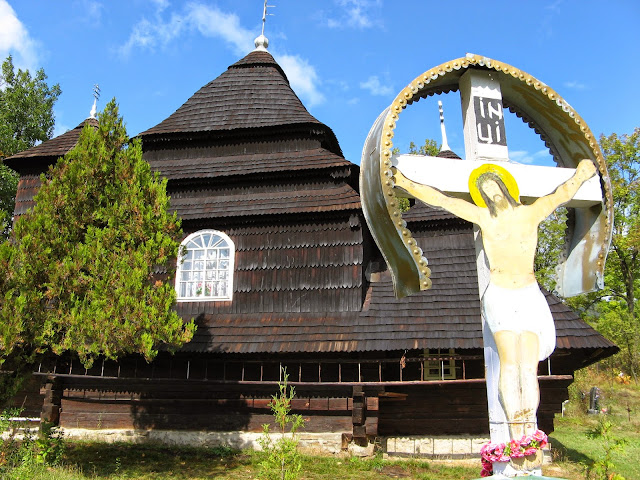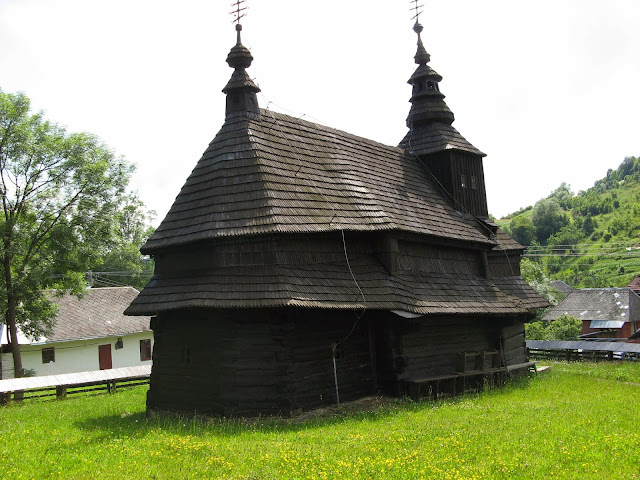This blog is dedicated to the wooden churches and other forms of traditional folk architecture found throughout Central & Eastern Europe, particularly the Carpathian Mountains region in Ukraine, Slovakia, Poland, Romania and the Czech Republic. My eventual goal is to visit and photograph all of these churches, and I will post the photos and a description of each of them here.
Wednesday, January 29, 2014
Uzhok, Ukraine
This small church, found in a remote corner of the Carpathian highlands of Ukraine, was declared a UNESCO world heritage site in 2013 together with fifteen other tserkvas in Ukraine and Poland. The village of Uzhok lies in the Uzhok pass, the highest pass in this part of the Carpathians and one of the most scenic locations in Transcarpathian Ukraine. The church is one of the most famous in the region and often features in tourism and other promotional materials as a symbol of Transcarpathian Ukraine.
The church was built in the Boyko style in 1745 and dedicated to Saint Michael. Supposedly the church was originally placed higher up the slope of the hill, but it was moved down nearer to the road because it was difficult for elderly villagers to walk up the incline. The architectural proportions of this church make it one of the most perfect examples of the Boyko style of architecture. The large triple-layered roof above the nave stands above the smaller single-layered roof of the narthex and the double-layered sanctuary roof. The shape of the tower above the narthex is similar to that of churches in the Lemko style found a little further to the west in the Carpathians.
The brightly coloured interior has had several modern additions to its fittings and decorations, but still has a pleasing appearance overall. The 18th-century iconostasis has luckily been only slightly altered from its original appearance. The elegant windows with white framing are not an original feature and were added during a later renovation. The church exterior is covered in a dark coating of oil stain to protect the wood, and this has led to the church being referred to locally as 'the little black ship'.
Standing next to the church is a wooden bell tower, though its roof and upper walls are now covered in metal rather than wooden shingles. During World War One the government of Austro-Hungary (the state to which Uzhok belonged at that time) had the bells from the bell tower removed and melted down for military use. On the slope above the church is the village cemetery, with many older graves overgrown by grasses and trees.
The village of Uzhok is most easily reached by train, since there are several regional trains daily from Uzhhorod which run directly there. A few trains daily also continue onwards to Lviv to the north. There are a couple of buses and marshrutkas which run to the village daily from Uzhhorod, but the timing of the trains is more convenient to make a comfortable day trip. Just before arriving at the platform for Uzhok the train crosses a spectacular rail bridge across the valley, offering excellent views in all directions.
Tuesday, January 28, 2014
Ruský Potok, Slovakia
This small Orthodox church stands on a raised patch of ground in the centre of the village of Ruský Potok in the far northeast corner of Slovakia. The forested hills of the Poloniny National Park surround the village on three sides, and sections of the UNESCO-listed Beech Forests of the Carpathians site are also nearby.
The church was built in 1740 and dedicated to Michael the Archangel as a Greek Catholic church. Since the year 2000 it has been used by the local Orthodox church community, though services are only held on religious holidays and special occasions.
The church contains a three-section floor plan (narthex, nave and sanctuary) on an east-west axis which is typical of Greek Catholic churches found in this region. The church was built on a low stone foundation to enhance its durability.
Next to the church is a small bell tower which contains three bells. The bell tower is not part of the original church plan and was built only in 1956. The three bells it contains were originally housed in the belfry in the tower above the narthex of the church. The tower features a series of small windows, which is a unique feature among the churches found in this region.
The iconostasis in the church likely dates from the eighteenth century. Due to the narrow space available in the small nave, the icons on the far left and right are placed on the side walls at a ninety degree angle to the rest of the iconostasis. This is another very unusual feature which does not appear in any of the other churches in this region.
The church was originally surrounded by a stone wall with two entrance gates, though at present there is a wooden fence with one entrance gate leading down towards the village square. A modern church has been built within the same grounds as the original wooden church.
Ruský Potok is very difficult to reach by public transport, since no buses run to the village and just a few buses per day pass along the Snina - Ulič road four kilometres to the south. The road into the village from the Snina - Ulič main road is paved and fine for access by car or bicycle. There is a blue-marked hiking trail over the hills connecting the villages of Topoľa, Ruský Potok and Uličské Krivé, and since all three villages contain wooden churches this route makes a nice one day trek.
Subscribe to:
Comments (Atom)













